What is Mansaf?
Mansaf is a Jordanian lamb dish that consists of pieces of lamb, rice and yogurt. Mansaf is usually served in an aluminum tray with the meat surrounded by rice on one side and yogurt on the other.
This particular rice dish is believed to have originated in Jordan, and it can be found all over the Middle East. There are many variations of Mansaf with different spices and vegetables such as okra, that adds unique flavor to the meal.
The dish is most popular during the holy month of Ramadan, but it is also served on other special occasions such as weddings and births. It can be eaten with bread or rice depending on the region.
What Do I Need to What do I need to make mansaf?
Mansaf is a traditional Palestinian dish that includes meat, lamb or chicken and rice. The dish can also be made with bulgur wheat instead of rice. In addition to the ingredients listed, the dish also often includes vegetables such as yellow summer squash, potatoes, and sometimes green beans.
How To Eat Mansaf
Mansaf is a common dish in Iraq, Lebanon, Syria and Jordan. It consists of thin layers of rice cooked with lamb or chicken and vegetables like zucchini or eggplant. The rice is traditionally served with yogurt, tomato sauce and fresh herbs like parsley.
What is Jameed
Jameed is a cream-based soup that originated in the Middle East. It has a thick consistency and is usually made with rice, fava beans, and chickpeas. Some variations of the dish include adding chicken broth and/or lemon juice.
Traditional Jordanian Mansaf
Sometimes calling a dish “traditional” can be misleading.
Sure, mansaf has been long associated as the national dish of a young modern Jordanian nation, but key parts of this yogurt, meat and rice pilaf were introduced as recently as last century. For a land with such a deep and rich history – like Petra, one of the 7 World Wonders – a dish with 100 years of history seems almost like a drop in the bucket.
Nevertheless, through its many different parts, mansaf is as deeply woven into various woven into Jordanian culture as you might find anyplace else.

Mansaf, Thereed, Transjordan & the Hashemite Kingdom
Now, before we dive into the history of mansaf today, we need to make a couple things clear from the start. First, mansaf has become and is certainly today one of the premier dishes in the Jordanian cuisine. And second, the dish itself draws upon the country’s strong Bedouin influence that itself is a paramount piece to the overall national identity.
To describe mansaf as a “traditional Bedouin dish,” however, would be a mistake, and here’s why.
You May Also Like…
If you love rice dishes, you should also check out our other Peruvian fried rice with a Cantonese flair, or a Jordanian rice pilaf with lamb and yogurt sauce (mansaf with jameed).
Feel like eating your rice plain? Try our Korean Bibambap vegan with tofu and vegetables, or Korean Beef Bulgogi served with white rice.
Love chicken thighs? Try our saffron rice with marinated chicken thighs.
The Bedouins and Thereed
While we won’t go deeply into the strong tribal and honor-based culture of the Bedouins (something that would merit its own post altogether), it’s helpful to know a little about who they are.
Historically, to be a Bedouin implied that you belonged to a small ethnocultural group of nomads throughout the deserts of both the Mashriq, or the Middle East and Levant, and the Maghreb, or more in towards Northern Africa. The Bedouins have long been considered expert navigators and survivors in the harshest conditions of deserts like the Arabian, Syrian and Saharan. In fact, the etymologic root of the word Bedouin comes from the Arabic word badawi, which loosely translates to either “nomad” or “wanderer” in English.
One of the key elements to the Bedouins’ surviving and even thriving in these deserts lies in their agro-pastoral society. Traditionally, Bedouin tribes would tend to and travel with a large livestock of camel and goats, from whom they derived key staples of the Bedouin diet like meat (obviously) and dairy products like milk, cheeses, yogurt and even certain “specialty” products like jameed (which we’ll see later). Additionally, the Bedouins were masters of agriculture when not on the move. Wheat derived products like bulgur, dried and cracked wheat germ, or freekeh, roasted young green wheat stalks, were also key components to the Bedouin diet.
No dish exemplifies the Bedouin diet better than thereed. Thereed is long traditional Bedouin dish – one that is even referenced in both the Bible and the Qu’ran – combining meat with a curd- or yogurt-based sauce over a bed of wheat bread.
Thereed is oft considered the predecessor to what eventually became the contemporary mansaf recipe, although it took some intervention from external cultural forces to get where we are today.
The British Influence and the Rise of a Kingdom
This too is another topic we’ll probably cover in a full-length post later, but for now you just need to know that the early 20th century – particularly the end of World War I and the collapse of the Ottoman Empire – was a pretty big deal for the entire Middle East region. Lands that had been either defined by natural borders or already consolidated under Ottoman rule were divided up in what became known as Sykes-Picot agreement. Sir Mark Sykes was a Brit and Francois Georges-Picot was a French diplomat, and the two of them carved up the Middle East into pretty arbitrary borders that best served the political interests of their homelands.
One such land that came out of this agreement was the Emirate of Transjordan. The Sykes-Picot agreement created a lot of bad blood and violent revolts in the region, and so the British – who had gained mandate over the lands – needed to put a trusted figure in place as local ruler of the Transjordan lands. The man for this role turned out to be Abdullah from the house Hashim, a Saudi Arabian former Emir in the Ottoman Empire.
At least until 1946, with the development of the Hashemite Kingdom, there was a profound British influence on the local culture and particularly for the nomadic Bedouins.
In what anthropologist Joseph Massad characterizes as a sedentarization of the Bedouins, there were several major changes to the everyday diet from their age-old practices. For one, tea became a more consumed drink where coffee used to be predominant. Even the camel, a key component of the Bedouin diet, was gradually phased out in favor of more “British-favored” meats like beef.
But above all, one of the most impactful changes was the introduction of rice into the diet. Not at all part of the traditional Bedouin diet, rice – which is an imported ingredient – has made its way into all types of dishes, including a particular mansaf dish.
The Hashemite Kingdom and Mansaf
And so we come to how the contemporary mansaf came to be.
By 1946, the British expressed their intentions to reduce their presence and to transition Transjordan into a fully independent and sovereign state. With the signed Treaty of London, the British and Emir Abdullah of the house Hashim agreed to create the Hashemite Kingdom of Transjordan, for which the “Emir” would now be recognized as a full-fledged “King.” The transition itself has had a few setbacks along the way – including the 1951 assassination of now-King Abdullah I – but the Kingdom and monarchy has remained intact up until now. Abdullah’s grandson and great-grandson, King Hussein and King Abdullah II, have served as two long-tenured kings to the country since Abdullah I.
Along with the formation of this nascent nation, there was a campaign to create a national identity and to define what it meant to be “Jordanian.” As you might expect, part of this campaign involved the development of a culinary identity, and it is here that we come into the formalized coding of contemporary mansaf as a national dish drawing upon its Bedouin past.
About this Pilaf Recipe
The translated name of mansaf, or “large dish” in English, is pretty much a dead giveaway of what you can expect for the dish.

In a typical mansaf, there are four key components. First, there’s the layer of flatbread (often markook or shrak breads). Second, there’s the rice, which is then followed by the third component, the meat. Finally, there’s the jameed-based or dairy-based sauce. Most recipes will also include garnishments of roasted nuts (like we will in our recipe), but it’s hard to characterize it as a fundamental piece to the dish.
Now, to be fair, we need to caution you ahead of time that this is a bit more of a labor intensive dish than we try to make here on Arousing Appetites, but it was one that was both a fun adventure and well worth the excursion.
To begin, we’ll take a look at the middle pieces of the puzzle: the meat and the sauce.
The Meat and Broth
The source of all the flavor in mansaf begins and ends with your meat.

A fun little tidbit we learned along the way is that, since mansaf is a common dish to make when hosting guests, your choice of meat serves as a signal for your esteem and respect for your guests. At the high end of the spectrum is goat meat, which means you really like your guests. From there, lamb is the next level down of meat to serve, followed by chicken. So now you know how to gauge your standing with your hosts next time you see mansaf served at the table.
Whichever meat you choose will start by being browned and seared then boiled in a liquid. The intention here is to create incredibly soft, juicy meat as well as a broth to serve as the base of your yogurt sauce later.
In our case, we started with a lightly pre-seasoned (with salt and pepper) lamb that was seared with oil and onions until brown on the outside. You then systematically add your aromatic ingredients in spices – that will play the biggest role in forming the flavor of your broth – before adding water into your stockpot. Bring everything to a boil before letting the entire pot simmer for at least an hour.
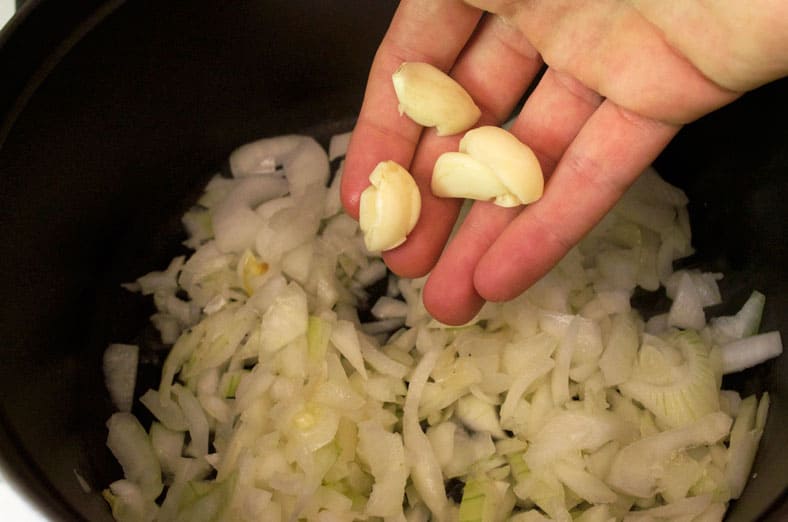
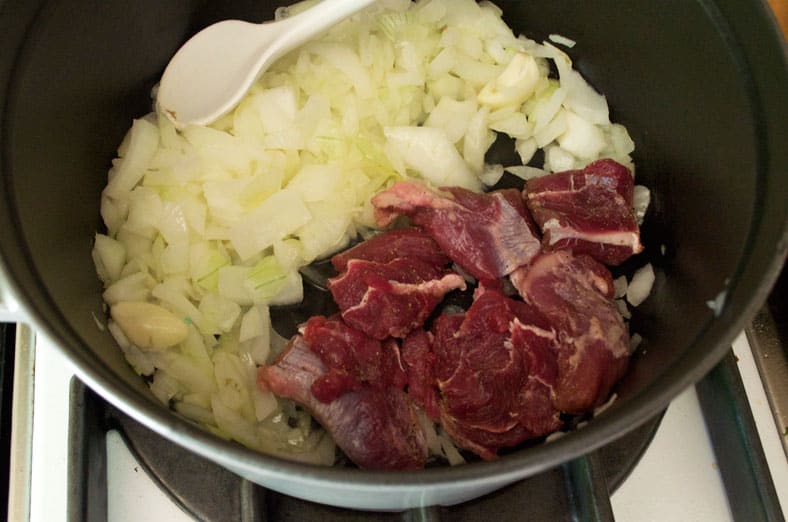


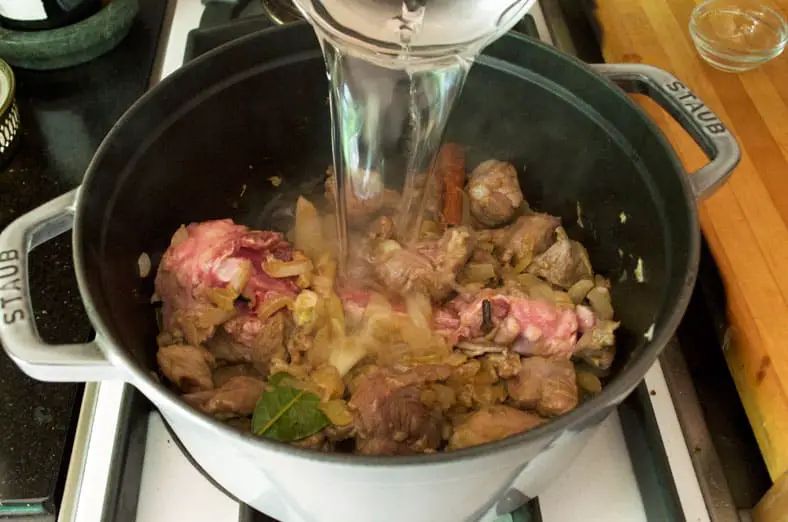
A quick note here is that, if you use lamb like we did, you’ll want to spend a few minutes spooning the white scum that comes out on the top of your boiling liquid. This helps remove germs and bacterias that really don’t anything to serve the taste of your broth.
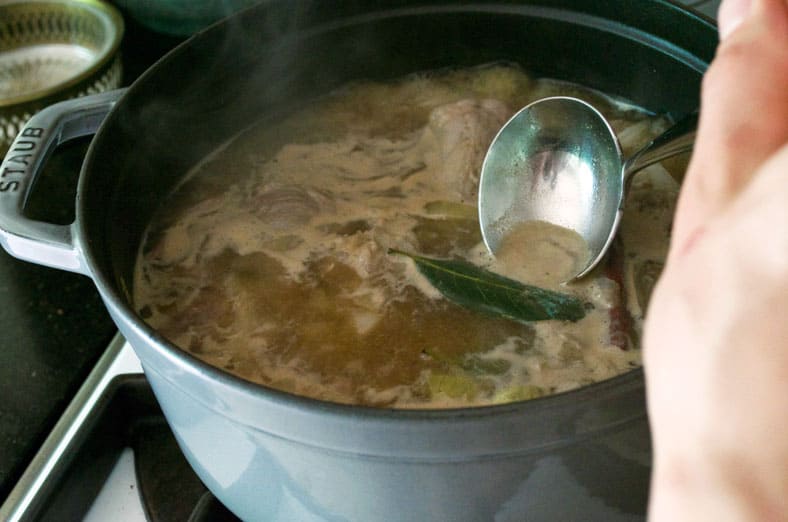
The Sauce
We’re jumping a little out of order here, but it’s a useful time to mention how the sauce is made. The base of your sauce will be the broth that comes from cooking the meat, so really what your sauce comes out as one of the last pieces made to the overall mansaf.
Nevertheless, once your meat has fully cooked and a delicious, decadent broth has been made, you’ll separate and spoon out a large portion of your broth and place into a separate bowl.
From here, the most traditional thing to do is to add an ingredient called jameed. Jameed is traditionally Bedouin cheese product made from either ewe or goat milk. The cheese is very heavily salted for several days, wrung out with a very fine cheesecloth and then sun-dried, all steps which cause the cheese to thicken and dry out. What you end up getting is almost like a rock hard ball (think a baseball) of cheese that can be very easily preserved and reanimated anytime.
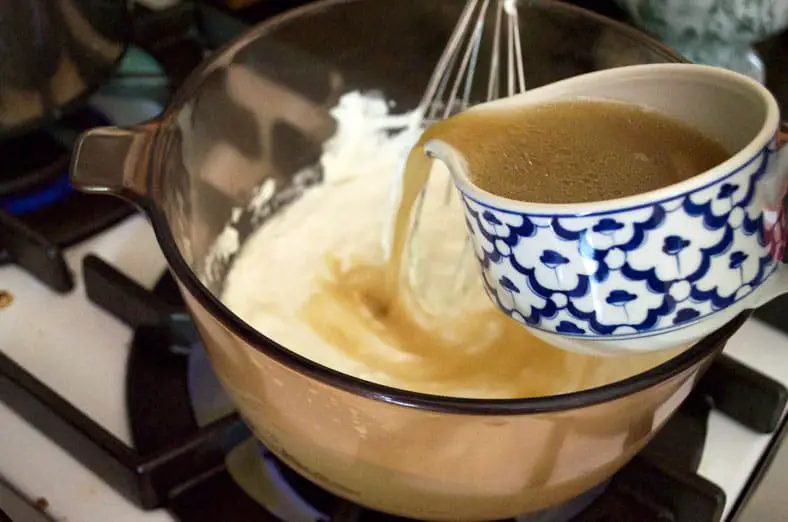
Whether you use jameed or another yogurt product (more on this later), you’ll add it to a simmering pot of half your meat broth and stir around until the dairy has dissipated and evenly distributed to create a creamy, salty sauce that is poured over the mansaf.
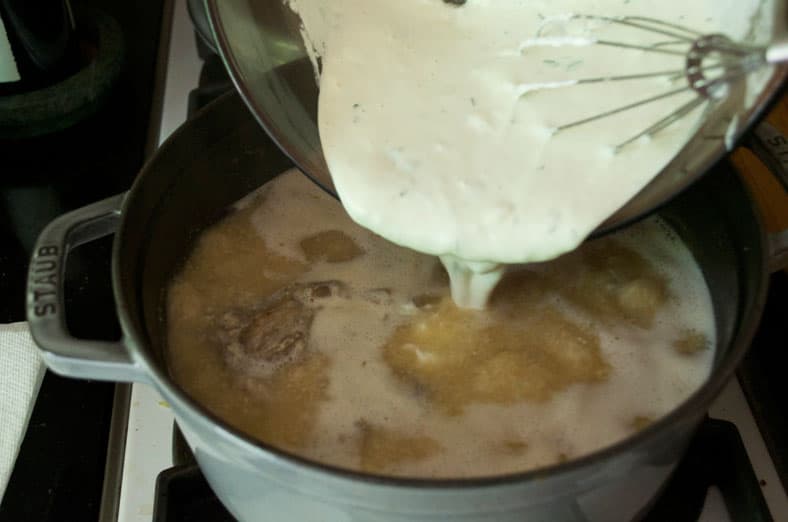
The “Others”
For the most part, the rest of the components of mansaf are fairly straightforward and easy to create. While your meat is stewing and your broth creating, you can tend to what we’re affectionately calling here the “other pieces.”
The most time consuming of the “others” here is the rice. What you’ll want to do is to set your rice either in a rice cooker or simmer in a pot and simply let it be until the grains are fully cooked. Some versions (like ours) will include ground up saffron into the water to cook the rice into a nice yellow color, but this is something that’s a bit more optional for you to do. We’d recommend it, though.
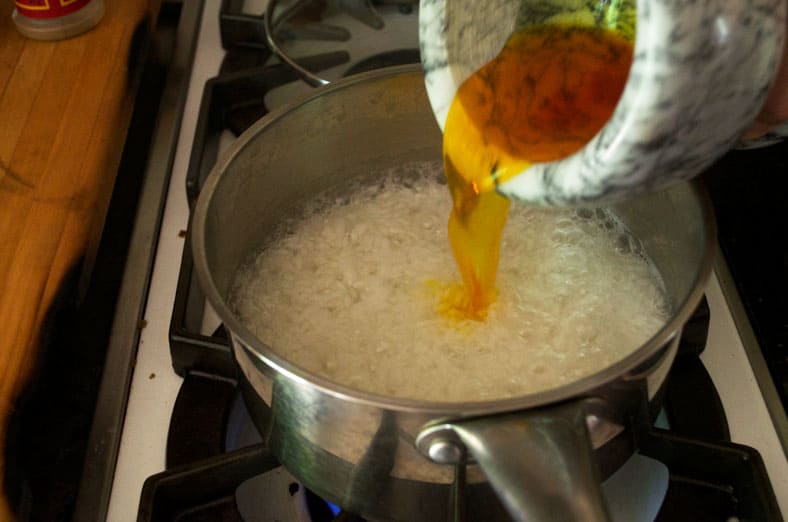

Next, most versions of mansaf will have roasted nuts as a garnish, which we’d highly recommend for your own because it really is so simple and adds such a wonderful taste to the dish. Simply take a small pan with some melted butter over a medium heat and jostle them for several minutes as they roast.
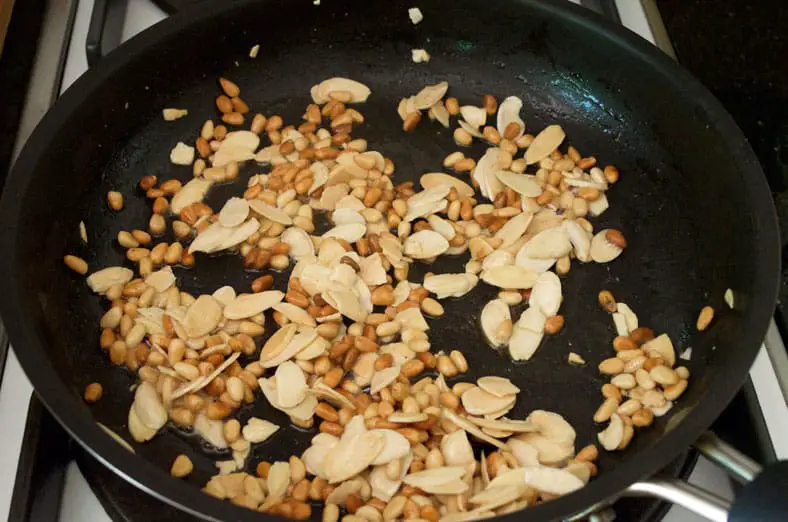
Of course, this would also be a good time to make sure you have enough markook bread or any similar thin flatbread to cover your impending large dish and to serve as your bottom layer.
Putting It All Together
Once you have all your components ready, you can start to compile your mansaf into the final dish. First, start with your markook bread on the bottom followed by a layer of your freshly cooked rice.


Then, layer the meat – which is incredibly tender and might even flake to the touch – directly above the rice. You can add a bit of extra broth if you have it, or you can just move onto the sauce.
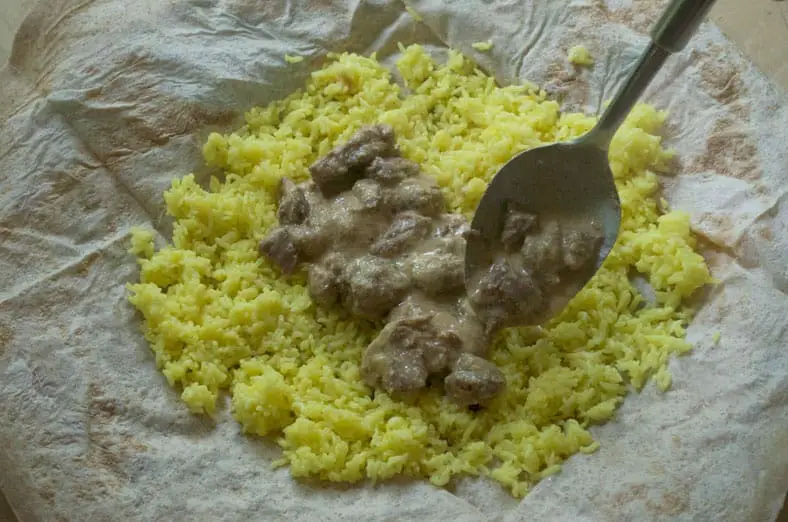
The sauce actually plays a large role in the overall presentation of mansaf. You will drizzle a little bit over the meat and rice itself, but make sure you have enough to serve extra for guests. As part of the mansaf tradition, how much yogurt sauce you serve extra for your guest is also an indication of how much you respect them. Most of the time, though, guests will serve themselves sauce individually, but it’s still good to keep an eye out in case you are served in this way.
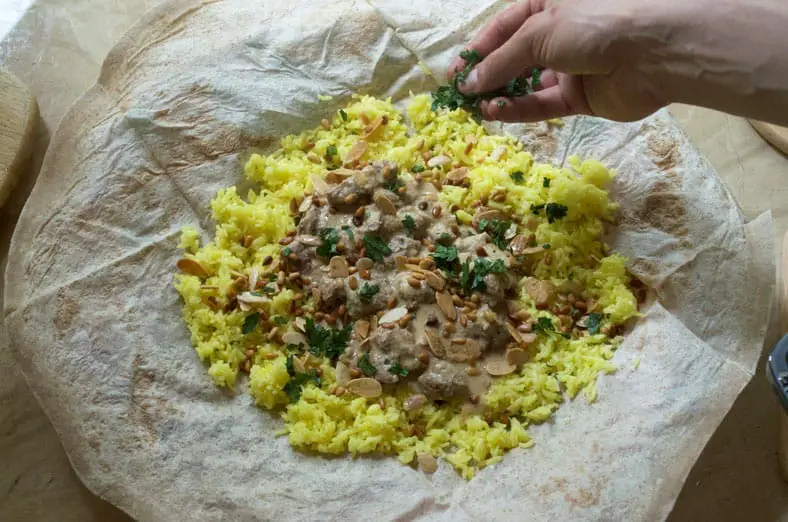
Finally, you’ll drizzle garnishes like your roasted nuts and fresh parsley on top, and then it’s time to eat!
How To Eat
What makes mansaf so special and inherently Jordanian is the communal aspect of eating. Here, there are no individual plates onto which rice and meat is served, instead you are expected to eat from one communal large dish (dare we say mansaf?).
To eat mansaf in the most traditional way, you start by standing up and placing your left hand behind the back. You’ll eat the mansaf with your right hand as a utensil since it’s believed that your hand will give a better taste to your bite than would any metal utensil.
Dig into your area of the plate to take a nice mixture of meat, rice and bread, with which you’ll then scrunch everything into a ball shape. Take big, hearty bites of the ball, and enjoy!
Just in case, here’s a wonderful walkthrough of how to eat mansaf properly:
Our Take on the Recipe
As such a prideful dish, there certainly weren’t any shortages of wonderful and detailed recipes on how to make a proper mansaf. That said, one recipe in particular caught our eye, both because of the recipe itself as well as a thoughtful breakdown of the components and history of the dish… I guess you could say we have a type. For that reason, we used this recipe as our original reference recipe.
There were, however, some changes that we needed to make, particularly when it came to ingredients.
First, finding markook bread was hard. We were able to find after some sleuthing, but we were very close to swapping the ingredient out either for Armenian/Persian lavash bread or really thin pita. It’s not the same by any means, but it would have sufficed in getting the job done.
For jameed, it was darn near impossible to find it anywhere, and so we had to get creative. We decided to recreate the jameed as best we could with Greek yogurt, arrowroot powder and some added quantities of sea salt. The danger here (which we became painfully aware of) is that you need to be really mindful of adding the yogurt into a warm and simmering broth to create the yogurt sauce. The best chance you have of creating a creamy similar sauce is to pre-mix and pre-heat your makeshift jameed ingredients with a good bit of hot broth already. Once it’s warmed up and already in pseudo-liquid, you can add it into your greater broth and simmer together.
From there, we made some minor tweaks into other components as well. We used saffron instead of turmeric for the rice for an added flavor to the overall profile. For the roasted nuts, we added a small dash of cinnamon for extra flavor as well, and we added mint at the very end of the yogurt sauce. In the meat broth itself, we also added a touch of cumin, which we found to be a lovely addition to the broth and meat flavor. Feel free to consider all of these adjustments as optional to your own version of mansaf.
Otherwise, this recipe is really as unique a meal as you might ever see. It does require a bit of finesse and patience to move through all the pieces of it, but the end result is so incredibly worth it.
Enjoy!
Have you tried mansaf before? Comment below!

💬 Recipe FAQs
1. How is Mansaf traditionally eaten?
Mansaf is traditionally eaten with the right hand by scooping up rice and lamb together on a large platter with bread on the bottom that soaks up all the yumminess. The dish is often served as a celebratory occasion for weddings or birthdays, but it can also be eaten for breakfast or lunch.
Most often it is eaten with shrak bread, but tortillas or other types of flatbreads work wonders here! Soak it up!
2. What can I substitute the lamb with?
You can try substituting the lamb with beef or chicken. The taste will change and it may not be as rich.
When substituting, make sure you keep the ratio of rice to yogurt to maintain the consistency of the dish
3. What other yogurt can I use besides Greek?
Mansaf is traditionally served with a thin, watery yogurt called laban. If you’d like to substitute for the laban, you can use regular plain yogurt, kefir, or sour cream.
4. How long can it store?
Fridge storage will keep it delicious for up to 5 days. If using the freezer, eat within 30 days for best taste!
📣 Similiar Recipes You’ll Love:
Qurotob Lamb with Yogurt on Flatbread
Lamb and Yogurt Albanian Casserole

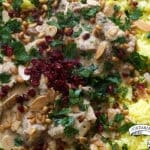
Mansaf: Jordanian Lamb, Yogurt and Rice Pilaf
- Total Time: 1 hour 25 minutes
- Yield: 6 people 1x
Description
Mansaf: Jordanian Lamb, Yogurt and Rice Pilaf with fined onion and garlic.
Ingredients
- 1 pound of lamb on the bone (we used lamb leg)
- 1 large onion, finely chopped
- 3 cloves of garlic, crushed
- 1 tablespoon cardamom pods, crushed
- 1 teaspoon whole cloves
- 2 tablespoons ground cumin
- 2 bay leaves (preferably fresh)
- 2 small cinnamon sticks
- 1 tbsp black peppercorns
- Water (dependent on how wide your pan is)
- 2 cups of Greek yogurt
- 3 teaspoons arrowroot powder
- 2 teaspoons sea salt
- 1 handful fresh mint, chopped
Roasted Nuts
- ½ cup almonds, skins removed (slivered almonds work here too)
- ½ cup pine nuts
- 1 tablespoon butter or ghee
- ½ teaspoon ground cinnamon (optional)
Rice
- 2 cups basmati rice or a similar medium grain rice, washed
- ½ teaspoon ground saffron
- 1 tablespoon grass-fed butter or ghee
- 1 teaspoon sea salt
- 3 cups water
For Serving
- 1 piece of markook bread (also called shrak or khubz)
- 1 handful of fresh parsley, chopped
- ¼ cup dried currants (optional)
- Salt and pepper to taste
Instructions
Stage 1 – Beginning the Mansaf Meat & Broth
- Start by fileting pieces of lamb meat from off the bone, but keep the bone for cooking. Pre-season the lamb with salt and pepper
- Take a large pot over medium high heat and add a dash of olive oil
- Once hot, start with your onion and garlic. Saute for several minutes for 1-2 minutes as they start to sweat and become fragrant
- Next, add your lamb. Move your onions and garlic to the side so as to let your lamb directly hit the heat of the bottom of the pan. Sear your lamb for 4-5 minutes as it starts to brown
- As the lamb browns, add your cumin, cloves, cardamom, bay leaves and cinnamon stick. Stir well for ~30 seconds to get the spices well integrated into the lamb, onions and garlic
- Then, add enough water to the pot so as to cover all your ingredients. Bring the heat to high and bring the entire pot to a boil. As the water boils, a white froth will come to the top of your boiling liquid. Scoop this liquid out with a spoon as much as you can
- After 2-3 minutes of boiling and fishing out the froth, reduce the heat to a simmer and cover your pot. Simmer everything together for at least 1 hour
Stage 2 – Tend to the Other Elements
- If using saffron threads, start by grinding the saffron with a pinch of salt in the mortar and pestle
- Pour a bit of hot (slightly under boiling temperature) water over the saffron
- As the flavors of the saffron come alive, take a small pot of water over high heat and bring to a boil
- When the water is boiling, pour your rice into the pot along with the warm saffron water
- Stir the rice and saffron water around in the boiling water until the entire pot has a nice orange hue to it, then
- Reduce the heat to a low simmer, then add the salt and butter. Cover and let the rice simmer for ~20 minutes
- While the rice cooks, take a pan over medium heat and add a tablespoon of butter. Once the butter is hot, lower your heat and add your pine nuts and skinned almonds
- Continually toss the nuts around as they start to toast, which should take about 3-4 minutes. As you toss and toast, sprinkle your cinnamon over the nuts if you wish to add it
- When the nuts have browned slightly and roasted, take off the heat and set aside
- After 20 minutes, uncover and fluff your rice. Re-cover and let the rice steam further until the rest of the Mansaf is ready
Stage 3 – Make the Yogurt Sauce
- After at least an hour of simmering, pour your pot of what has now become a lamb broth through a colander into a large bowl
- From the colander, fish the pieces of lamb pieces out and place back into the pot
- Add ½ of the strained stock back into the pot and bring the pot back to a simmered heat
- Take a separate pot over a low heat and add a mixture of your Greek yogurt and remaining strained stock. Stir well so as to evenly heat the yogurt and to mix it well with the stock to create a thickened liquid
- Once heated, pour the yogurt liquid into the larger pot with the lamb and mix well through. Simmer for 5 minutes
- After 5 minutes, add your arrowroot powder and stir well through. Simmer for another 5 minutes as the sauce begins to thicken
- Finally, take the pot off the heat and add in your mint and stir well
Stage 4 – Compile and Serve the Mansaf
- To serve, start by laying the mankook bread flat in a platter or dish
- Next, layer your rice on top of the bread
- On top of the rice, ladle pieces of lamb meat followed by spoonfuls of the yogurt sauce. You’ll have extra yogurt sauce left over, which people can add to their own bites based on their preference
- Finally, sprinkle the roasted nuts and fresh parsley over the mansaf. And you’re done! Enjoy!
- Prep Time: 10 mins
- Cook Time: 1 hour, 15 mins
- Category: Main Dish
- Cuisine: Jordanian


That looks like an amazing meal!! My husband is half Lebanese so we do eat a lot of Middle Eastern food…I’d love to try this one.
Thanks Michelle! We’d love to hear what you and your husband think if you do make this. There are certainly a lot of shared influences between this dish and famous Lebanese ones 🙂
What a wonderful meal. Almost like an elaborate Moroccan cous cous based feast, though with rice instead of cous cous and a dairy component too. You’re right that the preparation is a bit laborious, but it does look spectacular.
Right you are that it’s slightly laborious, Laura, but it’s more a waiting game than having to actively tend to a stove for hours at a time. The end result were some really memorable eating experiences though, especially as we learned how to eat it correctly. Can’t recommend it enough 🙂